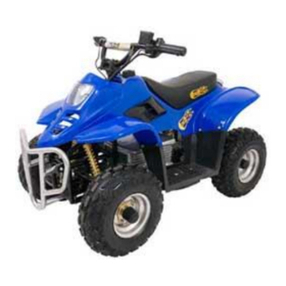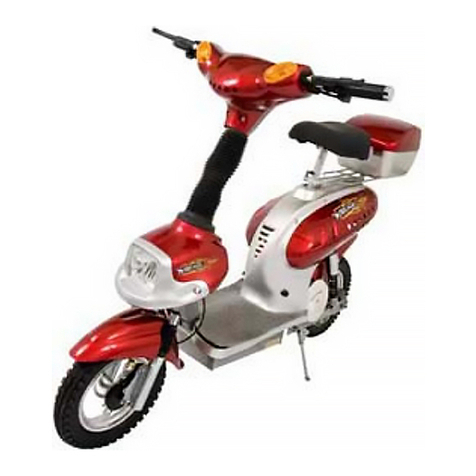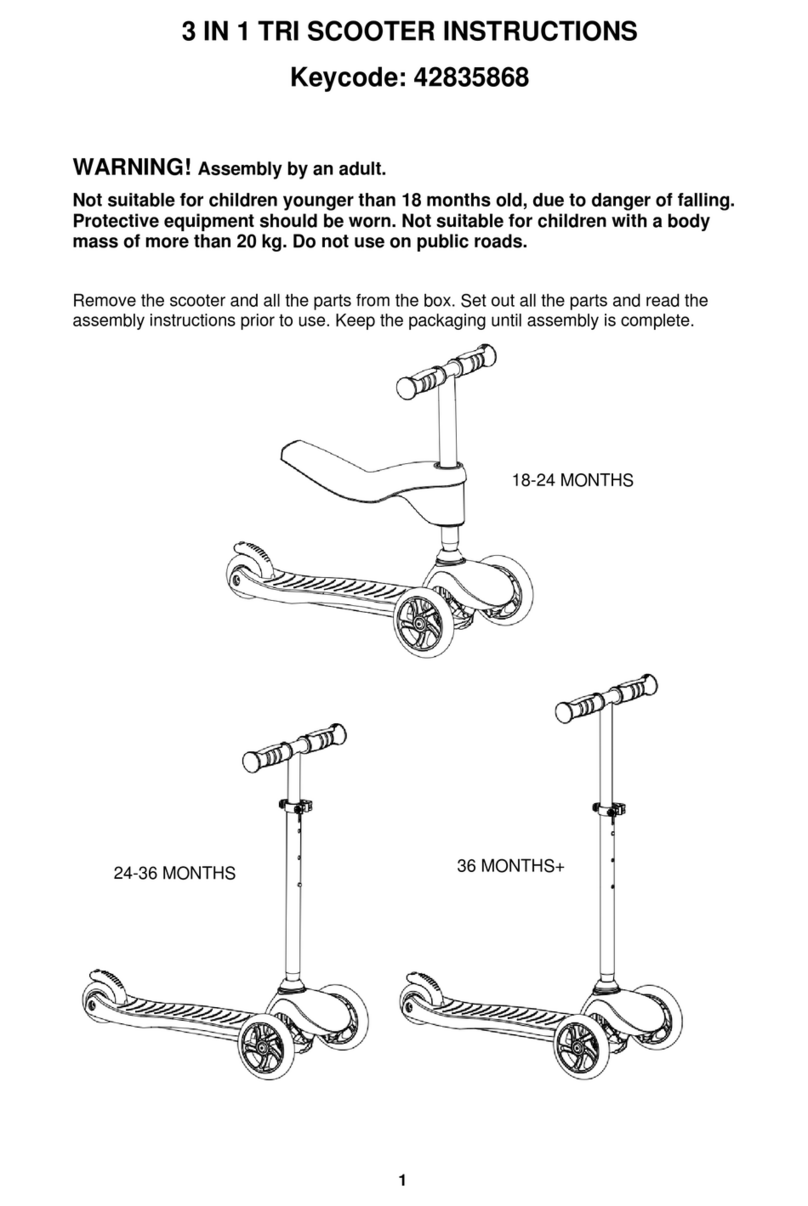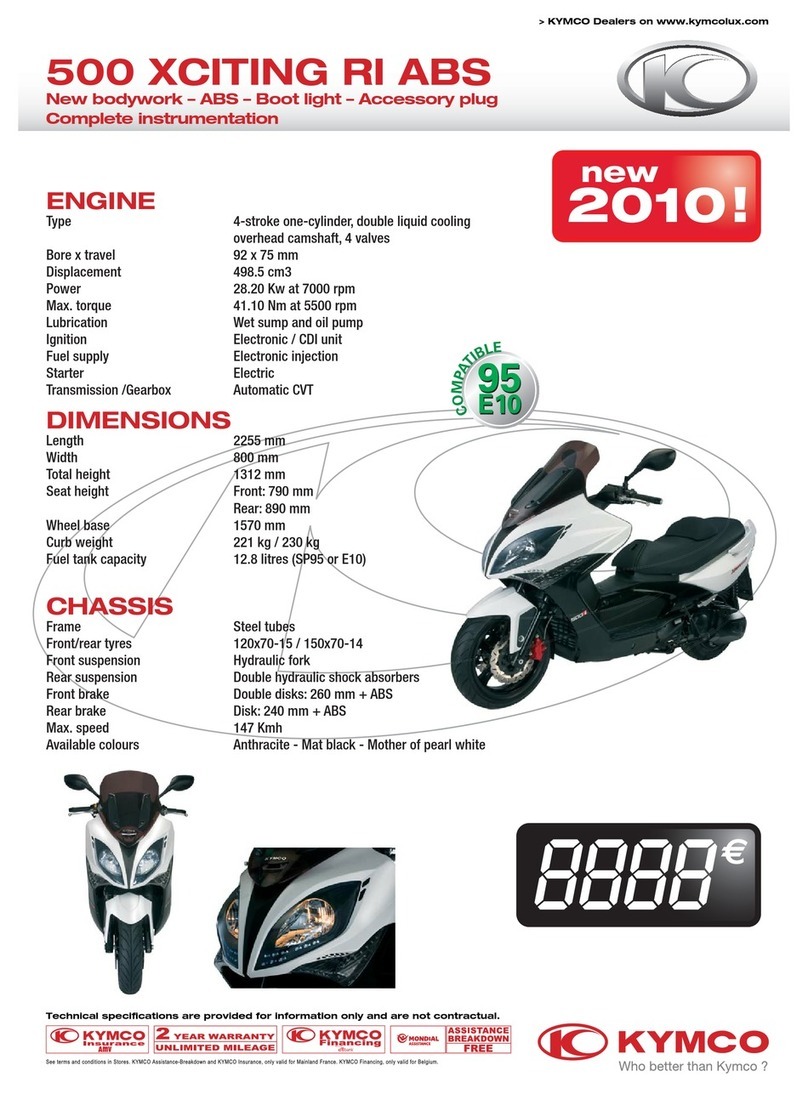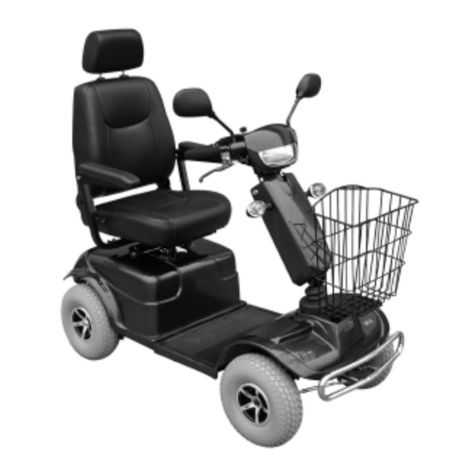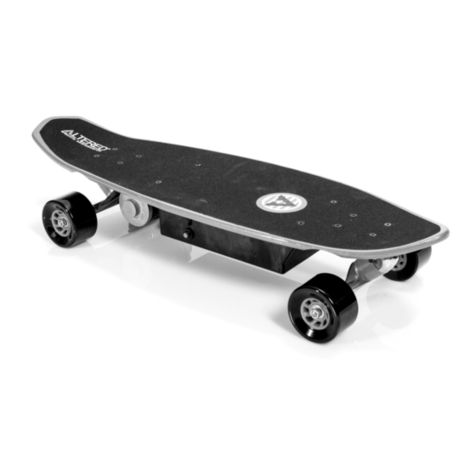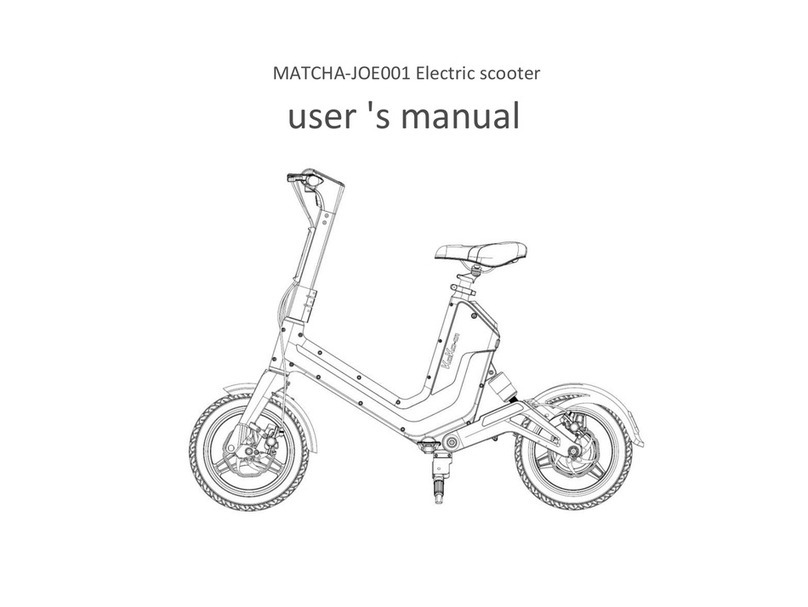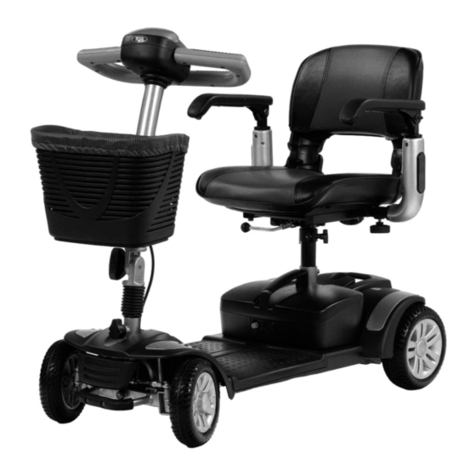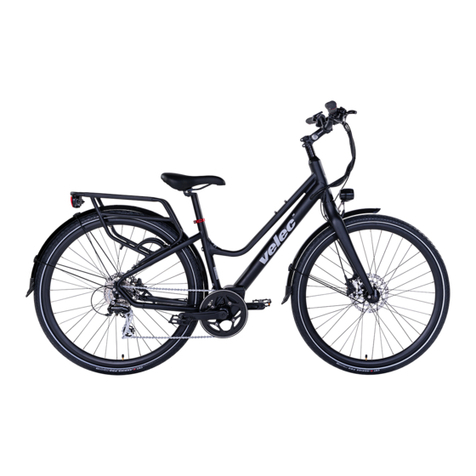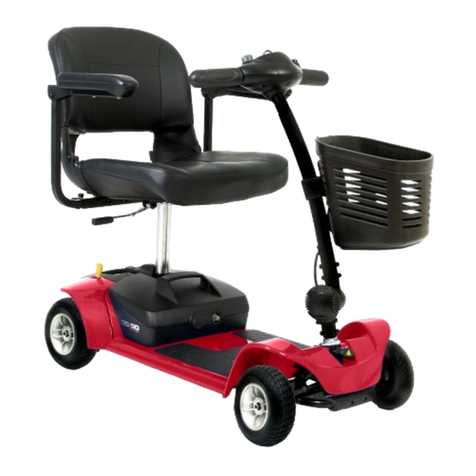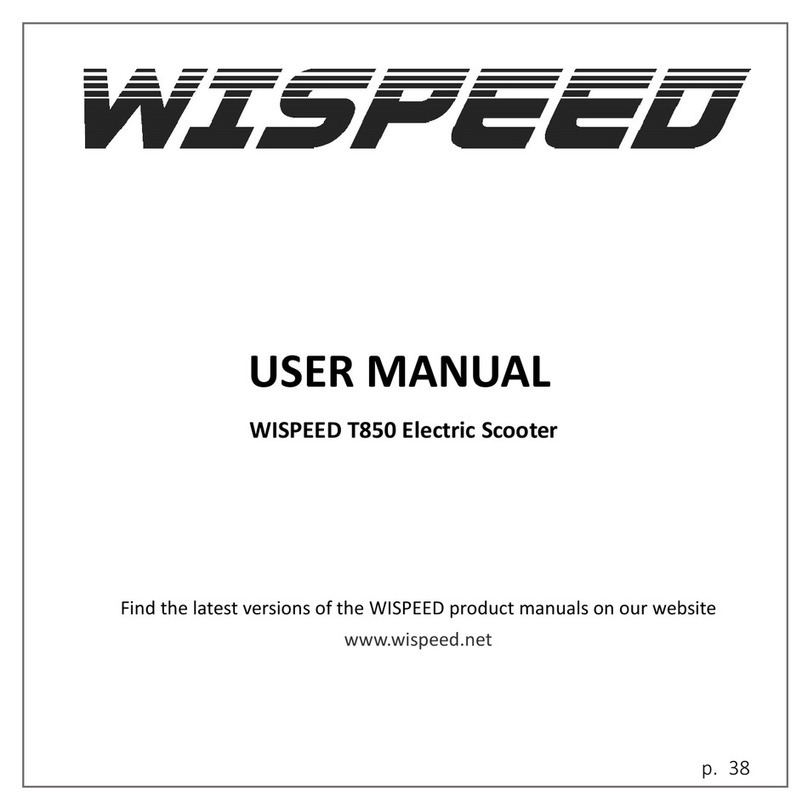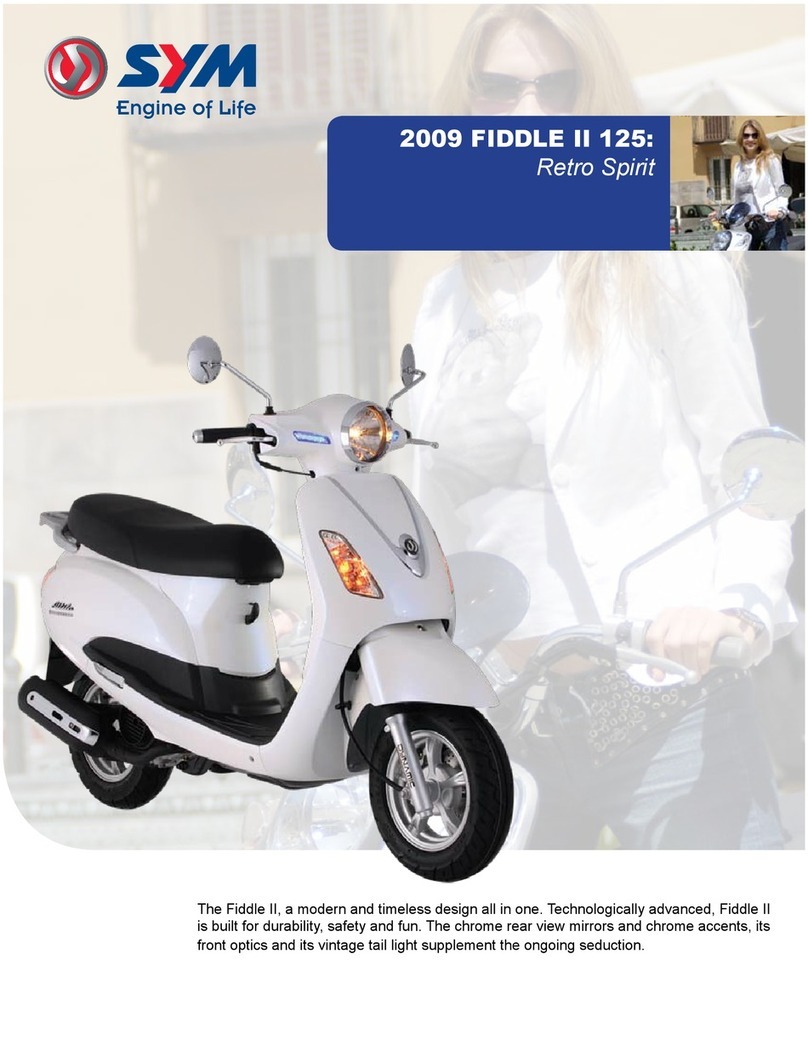Xtreme XM-3150 Troubleshooting guide

1
ZERO EMISSION
CLEAN ENERGY
HIGHPOWERELECTRICSCOOTER
XM-3150
Operation and Maintenance Instructions
We strongly recommend that you read this entire
manual before using your vehicle for the first time

2
Contents Page
P01 General Instruction Before Riding
P02 Point Inspection (Pre-ride Check)
P03 Assembly Instructions
P04 Equipment Location
P06 Ignition Key Positions
P07 Handle Bar Controls
P08 Accelerating & Braking
P09 Battery & Charging
P10 Easy Maintenance
P11 Maintenance Schedule
P12 Diagnostics Indicators
P13 Frequently Asked Questions
P15 Technical Specification
DO NOT RETURN TO STORE!
Do not use this vehicle for the first time until you have inflated the tires to the correct PSI
and completely charged the battery. Failure to follow these instructions may damage your
vehicle and void your warranty.
CALL TOLL FREE OR GO ONLINE
1-800-772-3852 www.x-tremescooters.com/support/
For General Information or Parts Visit www.x-tremescooters.com

3
General Instruction Before Riding
1) Tire check - Check the tires for correct inflation pressure and for any signs of physical damage.
2) Brake check - Squeeze the brake lever (Front then Rear) as hard as you can, push the scooter
forwards and check the braking force.
3) Safety Circuit Breaker - When the key is inserted and turned to the ”ON” position, the power
indicator will illuminate. If persistent current is over 60A, the power will be automatically cut off to
avoid over-heating and damage. Wait for one minute and then reset the circuit breaker located under
the seat to restart your scooter. This circuit breaker is switched off before delivery, please switch on
before riding.
4) Battery Check - Make sure your scooter is sufficiently charged and always check the battery
gauge while you are riding and be sure that it does not get too low too often.
5) Steering - Inspect the handlebar for any damage. Apply the front brake and push the handlebar
up and down to check for any unusual noises. Move the handlebar in all directions to check for any
loose parts or obstructions. Any problems should be corrected before use.
6) SAFETY NOTICE
6.1. To prevent the scooter moving away unexpectedly, always turn the key to the “OFF”
position before dismounting or leaving the scooter unattended.
6.2. Always engage the rear brake when mounting or dismounting the scooter. Ensure that you
are seated on the scooter and check that the stands are clear of the ground, before touching the
throttle. If you twist the throttle before you are ready to go or while you are mounting the scooter it
may move away from you and could lead to an accident.
7) Water and Cleaning - Your scooter can be ridden in wet and rainy conditions. When riding in rain,
do not ride through deep puddles or muddy areas as excessive water will cause the motor and other
electrical components to suffer damage. During cleaning, as with any motor vehicle, be sure to avoid
soaking any electrical component to avoid serious damage.
NEVER USE A HIGH PRESSURE WASHER WHEN CLEANING THE BIKE.
8) Parking - Your scooter should not be left in strong, direct sunlight or heavy rain for extended long
periods as this will prematurely age and damage paintwork and the general finish of the scooters
appearance and some of the electric components may overheat.
9) Riding - Never overload and ride your scooter. Prolonged use with excessive weight could cause
serious damage to the electronic and mechanic parts and void your warranty. It is recommended that
all new scooter riders enroll in rider training for safety reasons.
10) Road Rules - As with any vehicle, a scooter rider must always comply with the local road traffic
rules and regulations. Before taking your scooter out on a public road, make sure you are familiar
with traffic rules and regulations and any special requirements for motorcycles & scooters.
11) Never drink and scoot! Alcohol slows reflexes and greatly limits your ability to operate a
scooter. Even a very small amount of alcohol will reduce your ability to operate a scooter safely.

4
Point Inspection before every use (pre-ride check)
The following checks/operations are necessary before riding and
delivering.
ALWAYS:
1) Always Charge the batteries (observing battery guidelines) before
using and after every use.
2) Check the action of the front and rear-wheel suspension.
3) Check the functionality of all controls.
4) Check the screws, nuts and fastening parts;check main and side kick stands,
suspension strut, yoke and steering-head bearing; check the motor to be sure it is
working properly.
5) Check the lights/headlight.
6) Check all main screws.
7) Check the tire pressure.
8) Check the function of the front and rear brakes
9) Perform a final inspection of the following elements: steering,
brakes, instruments, indicator lights, lights and signal system, as well as the tires
and wheels.
Installing the rear view mirrors
1. Mirrors must be attached to the handle bars between the grips and the brake
handles.
2. Screw in the rear view mirrors clockwise. The left side mirror is curved to the left
and the right side mirror curves to the right.
3. Secure the rear view mirrors by tightening the bolts.
3. Clean and adjust both mirrors before you ride. Mirrors should be adjusted so
you can see the lane behind you and the lane next to you as far as possible.
When mirrors are properly adjusted you can see the edges of your arm and
shoulder while in the normal seated riding position.

5
Equipment Location

6

7

8
Ignition Key Positions
Key Position Description
On Key cannot be removed when power is on.
Off Key can be removed when power is off.
Lock Handlebar Turn the handle bar to the far left and turn the key to the lock position
to prevent theft. The key can be removed when handle bar is in the
lock position.
Opening the seat Turn the key in the slot to release the seat’s locking mechanism and to
access the charger port.

9
Left Handle Bar Controls
Headlight Switch High Beam: Push switch up
Low Beam: Push switch down
Horizontal Switch Left Turn Signal: Slide switch to the left
Right Turn Signal: Slide switch to the right
Turning off Signal: Press central release button
Horn Button Horn: Push red button on the left.
Rear Brake Lever When rear brake handle is compressed the rear wheel will
slow to a stop and power will be cut off. Power will flow once
lever has been released.
Right Handle Ba
r Controls
Front Brake Lever
When front brake handle is compressed the front wheel will
slow to a stop and power will be cut off. Power will flow once
lever has been released. To start, turn the throttle counter
clockwise.
Throttle Turn throttle counter clockwise to increase speed.
Parking Lights Dashboard lights, headlight and taillight will turn
on when the switch is in the middle position.
Head Light The dashboard lights, headlight and taillight will turn
on when the switch is in the left position.

10
Accelerating and Braking
Throttle Tips
1. Turn the key to the ‘ON’ position, then turn the Throttle gradually to accelerate.
2. To avoid losing control of your scooter, please turn the Throttle slowly until the
speed increases.
3. Do not turn the throttle until you are ready to ride.
4. After braking, make sure the throttle has been released back to the start position,
release the brake levers and turn the throttle gradually to move again.
5. The brushless motor makes a small electromagnetic noise when turning the
throttle to start. This is normal.
6. Please, for your safety and security, take the key out when you are not riding.
Braking Tips
1. To stop, release the throttle and apply the front and rear brakes simultaneously.
2. For safety, this scooter has a circuit brake system. When the front and rear
brake is applied, the controller will disable the circuit; release the throttle back to the
start position, release the front and rear brakes to enable acceleration again.
Tips for better economy (range)
1. Accelerate slowly and smoothly. Avoid hard acceleration.
2. Avoid sudden braking by attempting to anticipate your need to brake ahead of
time.
3. Release the throttle and just roll along without using any power where possible.

11
Battery Gauge and Charging
Instructions
Marks Description
Green When the battery is fully charged(over 75%). The needle
will point to the upper green section.
Green(2nd) When the battery is around 75% charged, The needle
will point to the lower of the green section.
Yellow When power is low (around 50%) the battery gauge turns to yellow.
You need to recharge your scooter as soon as possible!
Charging
● The batteries in your scooter are high performance, sealed and maintenance
free D/C battery. The owner must use the factory-supplied charger with a 110V
(or 240V) power outlet.
● Turn off all switches while charging the battery. Plug one side to a 110V (or
240V) outlet and the other to the charging plug located under the seat.
● The average charging time is 4 hours (80%) by a 5A charger. To fully charge
battery, charging time will be 6 hours.
● To keep the batteries in good condition, charge them after each use. Please be
sure to charge the battery fully once a month, even when the scooter has not
been ridden.
● Your batteries do not develop a memory (i.e. you do not need to run it down
completely to achieve a good charge) and the batteries can be charged at any
time in the discharge cycle of the battery. In fact the reverse is true, regular
charging will lengthen the life of the batteries.
Battery Longevity
The driver should, if possible, charge the scooter after every trip as this will help the
battery’s life. The life of the B.B battery (VRLA) is 300 deep cycles (100%
discharged), but if you charge the battery every time or when its capacity falls to
50%, the battery life will be greatly increased. Therefore we advise the rider to
charge the scooter as often as possible.

12
Easy Maintenance
Good maintenance will play a major role in keeping your scooter in good working condition
and prolong the life of the batteries and scooter. Please follow these recommendations:
◆ Rust prevention
★ Always keep your scooter dry and clean.
★ Avoid parking your scooter in high humidity and corrosive areas.
◆ Tires
★ Regularly check the tires for signs of damage, excessive wear whether normal
or abnormal. Any damaged or worn tire must be replaced before riding.
◆ Body
★ Always check your scooter’s body parts and frame for correct fit and any sign of
damage.
★ Check and tighten all nuts and bolts.
◆ Water
★ Always check for excessive moisture in or around electrical components. If
water is found, please dry the area first and then apply a suitable water dispersant
according to directions. Remember to avoid contact with water where possible.
◆ Electronics
★ Due to the complex nature of the electronic components of this scooter, you
should never attempt to take out any of the parts, or attempt major maintenance
without first consulting the supplier (this will invalidate the warranty).
★ To avoid damage to the electrical parts of this vehicle, especially the controller,
do not park the vehicle in direct sunlight or in heavy rain.
For customer safety, perform routine maintenance on your vehicle. This will
lower the potential for damage.
Remember... Prevention is always better than a Cure.

13
Maintenance Schedule
Regular Service Intervals - Miles
Miles 250 625 1250 1875 2500 3100 3700
Battery C C
Charger C C
Tire Pressure C C C C C C C
Tire Wear C C C
Brake System C C C
Brake Pad A A C C
Nuts and Bolts T T T T T T
Miles 4400 5000 5600 6200 7000 7500
Battery C C
Charger C C C
Tire Pressure C C C C C C
Tire Wear C C C
Brake System C C
C
Brake Pad A A A A A
Nuts and Bolts T T T T T
A: Adjust C: Check, refill, repair or replace if needed T: Tighten

14
Diagnostics Indicators
If your scooter fails to operate, please check the diagnostic indicators on the display
panel.
Symptom: Light 1 flashes
Diagnostics: This only applies to lithium powered scooters. The flashing light
indicates low voltage.
Solution: Please reduce the speed to obtain extra running miles and recharge the
scooter immediately.
Symptom: Light 2 on
Diagnostics: Faulty brake switch, kickstand down or missing, or motor overheating
can cause light 2 to illuminate.
Solutiom: Please take the following steps:
Step 1. Apply the brake lever and release it . The scooter will go back to
normal if light 2 goes off. If light 2 remains on, please do step 2.
Step 2. Kick up the side stand. The scooter will go back to normal if light 2
goes off. If light 2 remains on, please do step 3.
Step 3. Wait a few minutes until the motor cools off. The scooter will go back
to normal if light 2 goes off.
Symptom: Light 3 on
Diagnostics: Controller overheat protection
Solution:. Wait a moment untill this light goes off automatically and the scooter will
go back to normal.

15
Frequently Asked Questions
1. Fully charged, what is the range of the electric vehicle?
A. The Range is affected by the weight of rider, the type of terrain and the speed in
which the vehicle is driven. At speed of 20mph, a range of 55 miles has been recorded on a
single charge.
B. See the specification sheet for the full range and speed of the model.
2. Is riding an electric vehicle a comfortable riding experience?
A. Riding an electric vehicle is indescribably more comfortable than riding a gasoline
motor vehicle. The silence and the smoothness of a direct drive electric-motor-powered
vehicle are incomparable.
B. Quick accelerating-speed from 0 to 45mph takes only 8 seconds.
3. Do you have to warm-up the electric vehicle before riding it?
There is absolutely no warm-up time needed. Just turn the key and you are ready to go.
It cannot be any easier.
4. What about maintenance?
This motor bike is designed for minimum maintenance. Considering the fact that this
vehicle has no combustion engine, no transmission, no belts, no chains, no gasoline, no
lubricants, no ignition plugs, no carburetor, etc. Modular designed components are
practically maintenance free. The unique design of the direct drive system and the total
absence of belts or chains make this vehicle much easier to maintain than other electric
scooters. Practically any scooter dealer can do most of the maintenance that may be
required. The brushless motor is precisely that so there is never a need to change the
brushes.
5. What about parts, is it a problem getting parts for the scooter?
I. ALL parts can be purchased directly from the retailer you purchased from or by
visiting: www.x-tremescooters.com
6. Can the electric scooter be cleaned or washed with water without any concern?
A. As with any electric vehicle, care should always be taken when washing.
NEVER USE A HIGH PRESSURE WASHER WHEN CLEANING THE BIKE.
B. One should be careful not to pour water directly into the charger outlet, the controller
and the internal battery set when washing or cleaning.
7. Do you need to wear a helmet to ride the electric vehicle?
For safety reasons we always advise the use of a helmet. Always check with your local
law enforcement regarding helmet laws for your area.
8. Is it easy to recharge the batteries?
Yes, it is very easy. The user just needs to insert the input plug of the Battery Charger
into any regular wall outlet of AC110V (or AC220V) and the output plug into the inlet
located under the seat which is clearly marked on P.5. This will start to recharge the

16
batteries.
9. How can I know the batteries condition and energy level?
The display panel includes a battery gauge on the right, which clearly indicates the
power level of the batteries in your vehicle.
I. FULL: First green light is on.
II. 75% FULL: second green light is on.
III. 50% LEFT: yellow light is on. (At this level, charging is highly recommended.)
IV. Low 25% LEFT :red light is on. (Immediate charging is necessary).
10. Can a rider get burned while riding the electric vehicle?
Riders will not get burned from riding the electric vehicle. The vehicle does not have an
exhaust pipe like in gasoline scooters. Nothing heats up.
11. Why is this product the best available in the world today?
It has a Brushless motor. We emphasize ”brushless” not just because this is the latest
technology, but because these permanent magnet motors are supremely reliable! These
more expensive motors produce high torque at low speeds, keeping an acceptable balance
of torque and energy across the whole speed range. In addition to not wasting energy at idle,
the motors offer the advantage of using the permanent magnet motor’s energy recovery
capability during deceleration (regenerative braking), so the batteries recharge during
deceleration. Often other types of electric vehicles on the market today will still use sealed
brush-type motors that are dependant upon brush life that build up brush dust (residue) and
susceptible to wear over time which may affect maximum speed and electrical noise or
become problematic in other ways. Because these brush-type motors are sealed, it often
takes an expensive motor replacement to get them working again.
12. What is the Manufacturer Warranty?
6-Month unlimited mileage warranty, 1-Year Battery warranty & 1-Year Motor warranty.
This warranty is subject to the customer/rider/owner following recommended maintenance
and proper use at all times.
13. How to store in winter?
Take the following precaution to prevent storage damage or problems when taking the
vehicle out on the road again in the spring:
1). Switch off the circuit breaker which located in seat storage, clean thoroughly (not
with high-pressure cleaning equipment!). Then treat all metal parts with corrosion-protection
agent. Use a suitable cleaning agent on all painted and unpainted trim parts and on rubber.
2). The batteries should be stored where they are protected against frost and recharged
regularly. It is recommended that the batteries are recharged every four weeks while the
vehicle is in storage.
3). Lubricate all cables and the joints of all levers.
4). Increase the tire pressure to prevent flat tires as a result of storage.
5). The vehicle should be stored in a dry room and be covered with at least a weather
resistant tarpaulin.

17
Technical Specifications
Motor High efficiency 3100W Brushless Hub Motor
Battery 5x12v/35Ah Lead Acid ( VRLA) batteries
Charger 5A,110V-250V/50Hz-60Hz
Charging Time 4-6 Hours
Expected Life of
Battery 300 Deep Cycles for Lead acid battery (100% discharged)
Tire 3.5”x10” 4PR tubeless tire
Max Torque 135N.m
Max Speed 45 MPH based on 35AH VRLA Battery
Single Charge
Range 55 miles at a speed of 20 MPH based on 35AH VRLA battery,
terrain, load & weather may effect results.
Net Brake
Horsepower Front is above 700N, Rear is above 800N
Climbing Capacity 20% gradient
Max Load
Capacity/Rider
Weight 200 kgs or 441 lbs
Gross Weight 138 kgs or 304 lbs with 5* 35ah lead acid battery
Net Weight 78 kgs or 182 lbs (excluding the battery)
Battery Weight 60 kgs or 132lbs
Dimensions L70" x W27" x H47"
Brake System Front/ Rear: Disk brake

18

19

20
DO NOT RETURN TO STORE!
IF YOU NEED HELP
CALL TOLL FREE OR GO ONLINE
1-800-772-3852
www.x-tremescooters.com/support/
For General Information or Parts Visit
www.x-tremescooters.com
REVISED 3/18/10
Table of contents
Other Xtreme Scooter manuals
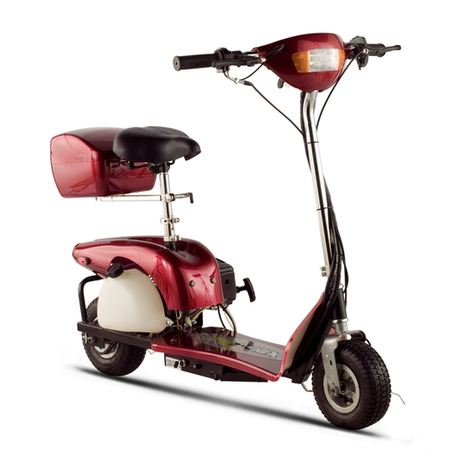
Xtreme
Xtreme XG-470 User manual

Xtreme
Xtreme XR-302 User manual

Xtreme
Xtreme X-140 User manual

Xtreme
Xtreme XB-700Li User manual

Xtreme
Xtreme X-250 User manual
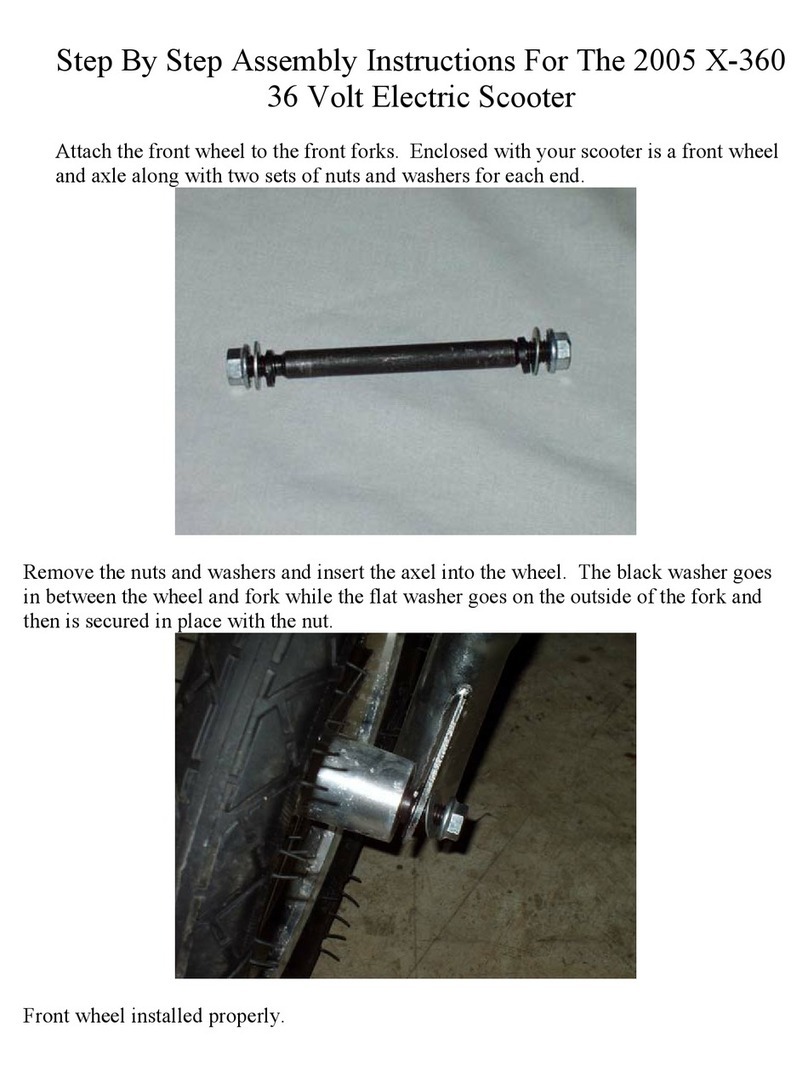
Xtreme
Xtreme X-360 User manual
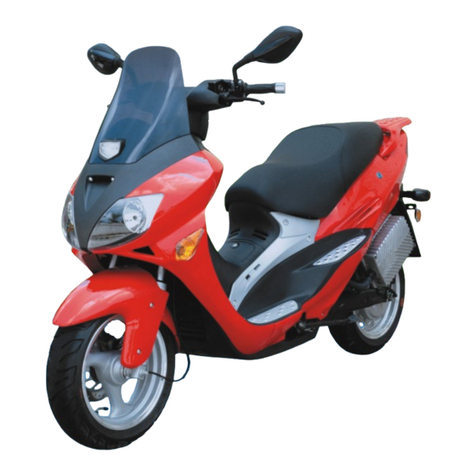
Xtreme
Xtreme XM-5000Li Troubleshooting guide
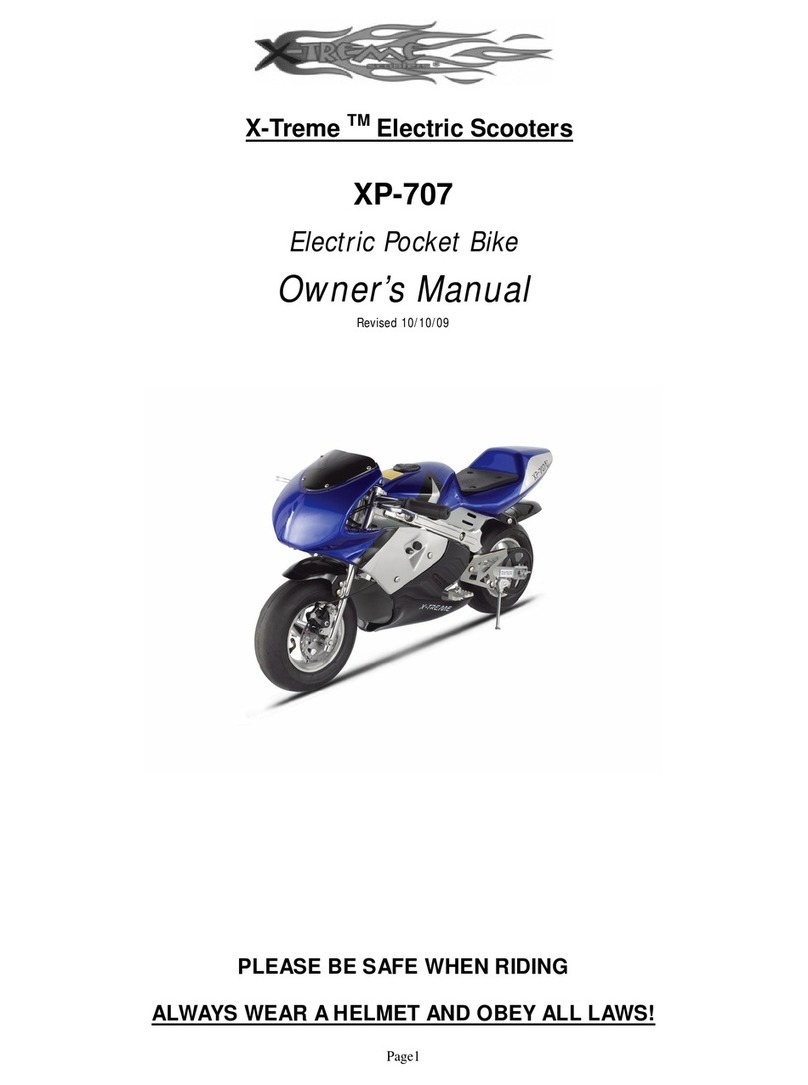
Xtreme
Xtreme XP-707 User manual

Xtreme
Xtreme XB-420M User manual
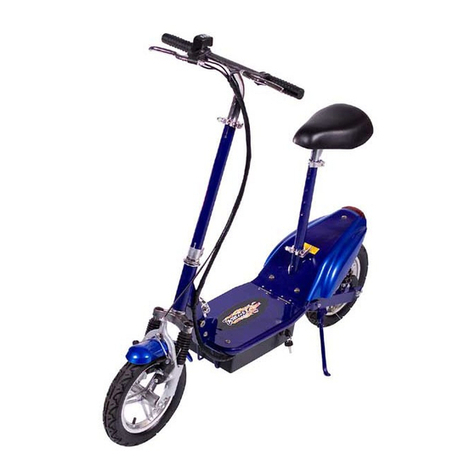
Xtreme
Xtreme X-400 User manual
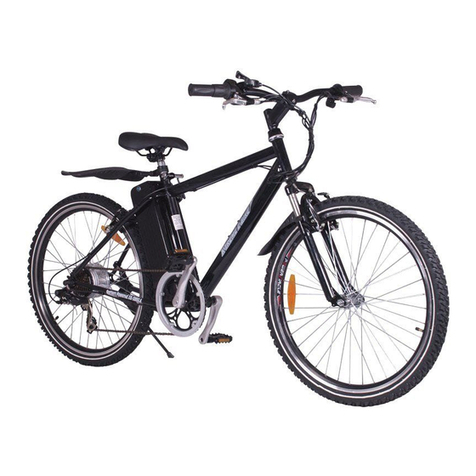
Xtreme
Xtreme XB-300SLA User manual
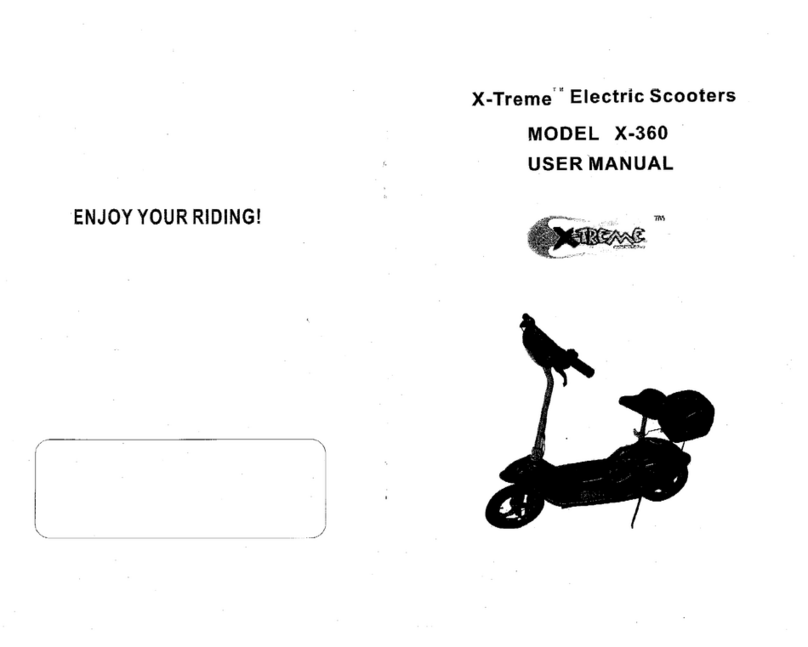
Xtreme
Xtreme X-360 User manual
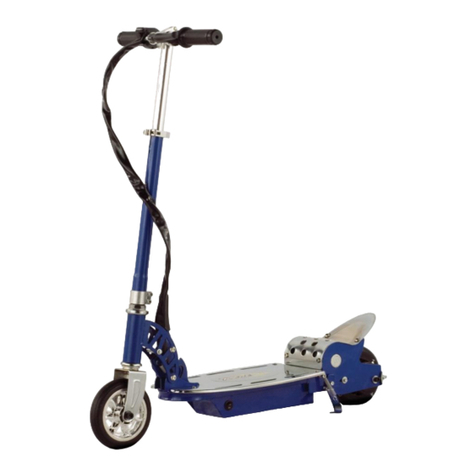
Xtreme
Xtreme X-140 User manual
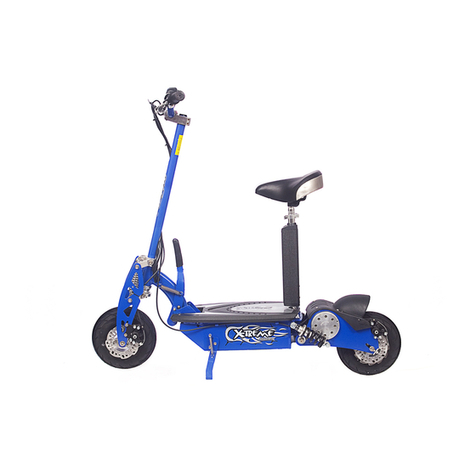
Xtreme
Xtreme X-600 User manual

Xtreme
Xtreme XMB-420 User manual
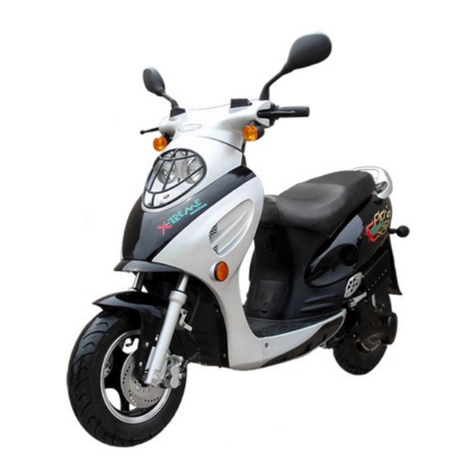
Xtreme
Xtreme XM-3000 Troubleshooting guide

Xtreme
Xtreme X-160 User manual
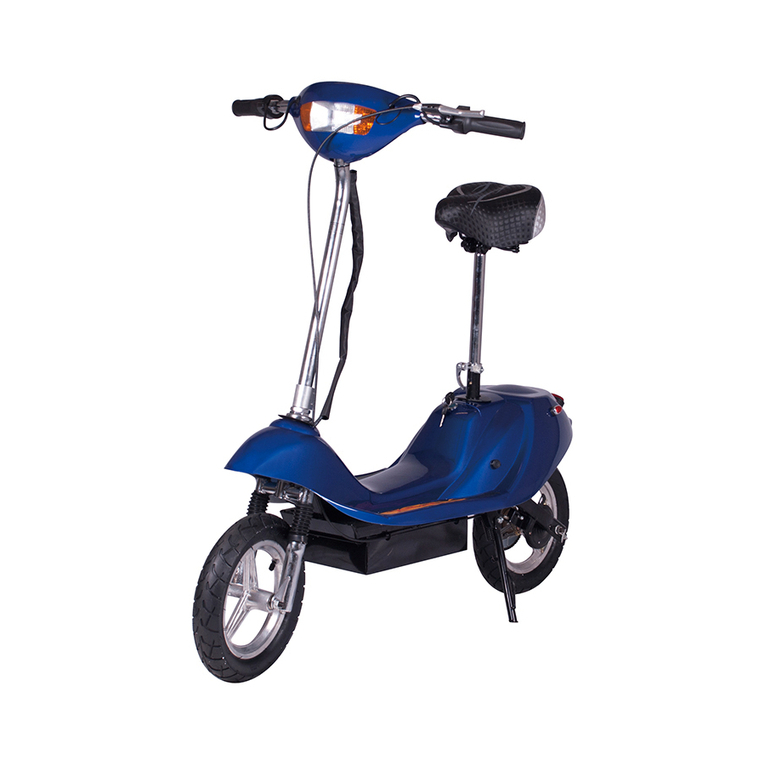
Xtreme
Xtreme X-370 User manual

Xtreme
Xtreme X-360 User manual

Xtreme
Xtreme X-500 User manual

